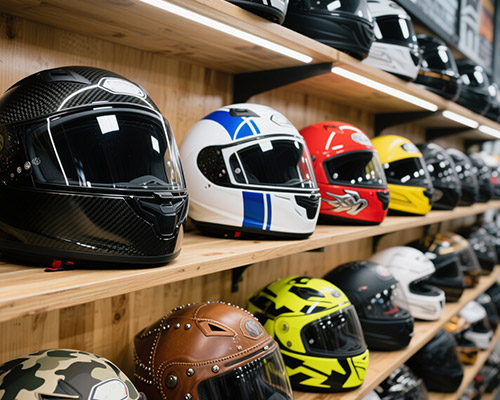Introduction
“After a crash, my head was fine—but the helmet cracked. That’s exactly what it’s designed to do.”
When shopping for a helmet, you might wonder:
Why does a 2,000carbon−fiberhelmetexistwhena2,000 carbon-fiber helmet exist when a 2,000carbon−fiberhelmetexistwhena20 plastic one does the job?
Why are some helmets feather-light while others feel like a brick?
What do terms like EPS, PC, or carbon fiber actually mean?
Today, we’re breaking down helmet materials—what really protects your head vs. what’s just marketing hype.
1. The 3 Core Layers of a Helmet
All helmets follow the same fundamental protective structure:
- Outer Shell
- Purpose: Distributes impact force and prevents penetration.
- Common materials: ABS plastic, polycarbonate (PC), carbon fiber, fiberglass.
- Impact Liner (a.k.a. Foam Core)
- Purpose: Absorbs shock to reduce brain trauma.
- Common materials: EPS foam (expanded polystyrene), EPP foam (expanded polypropylene).
- Comfort Liner
- Purpose: Improves fit and comfort.
- Common materials: Antimicrobial fabric, moisture-wicking mesh, memory foam.
Key Insight: The shell resists impacts, the foam absorbs them—skip either layer, and protection drops drastically.
2. Outer Shell Materials: From Cheap Plastic to Military-Grade Armor
① ABS Plastic
- Traits: Affordable, durable, but heavy (~300–400g).
- Found in: Budget motorcycle helmets, kids’ helmets.
- Pros & Cons:
Decent impact resistance, good value.
Can deform under heat, degrades in sunlight.
② Polycarbonate (PC)
- Traits: Lighter (~250–350g), more penetration-resistant than ABS.
- Found in: Mid-range bicycle and e-bike helmets.
- Pros & Cons:
Flexible, aerodynamic.
Brittle in freezing temps.
③ Composites (Carbon Fiber / Kevlar / Fiberglass)
- Traits: Ultra-light (<200g), extremely strong, premium-priced.
- Found in: Motorsport, pro cycling, and mountaineering helmets.
- Pros & Cons:
5x stronger than steel at half the weight.
Expensive ($300+), hard to repair.
Reality Check:
| ABS | 350–450g | ★★★☆ | 20–20–20–100 |
| PC | 250–350g | ★★★★ | 50–50–50–200 |
| Carbon | 150–250g | ★★★★★ | $300+ |
3. Foam Core: EPS vs. EPP—Which Saves Your Brain Better?
① EPS Foam
- How it works: Crushes on impact, sacrificing itself to absorb energy.
- Pros: Affordable, absorbs ~70% of impact force.
- Cons: Single-use—replace after any crash.
② EPP Foam
- How it works: Rebounds after impact, survives multiple hits.
- Pros: Durable, ideal for skate/snow helmets.
- Cons: Slightly less efficient than EPS, pricier.
Pro Tip: High-end helmets use multi-density EPS—softer foam near temples, firmer at the crown.
4. Comfort Liners: Sweat Management & Fit
- Basic Padding: Holds sweat, needs frequent washing.
- CoolMax/Antimicrobial: Wicks moisture, resists odor.
- Memory Foam: Molds to your head (but may overheat).
Winning Features:
- Removable liners for easy cleaning.
- Magnetic cheek pads (e.g., Shoei) for quick adjustments.
5. Cutting-Edge Tech: MIPS, Koroyd & Beyond
① MIPS (Multi-Directional Impact Protection)
- What it does: Lets the helmet rotate slightly to reduce rotational brain trauma.
- Best for: MTB, motorcycling.
② Koroyd® Honeycomb
- What it does: Crushes progressively (like a car crumple zone), 30% lighter than EPS.
- Used by: POC, Smith in skiing/snowboarding helmets.
③ Carbon Fiber 3D Weaving
- Next-gen: Seamless, ultra-strong shells (Arai’s high-end models).
6. Red Flags: How to Spot a Dangerous Helmet
Cheap helmets often cut corners with:
- Paper-thin shells (press with your thumb—if it dents, it’s unsafe).
- Missing foam layer (just a hard plastic shell = zero protection).
- Fake safety stickers (no DOT/ECE/Snell certification = gamble).
DIY Safety Check:
- Peel back the liner—is there a thick EPS/EPP layer?
- Does the shell have material markings inside?
7. The Verdict: How to Choose?
- Commuting/Casual Riding: PC shell + EPS foam (~50–50–50–100).
- Motorcycles/MTB: Fiberglass + MIPS + multi-density foam (~$150+).
- Racing/Extreme Sports: Full carbon fiber + Koroyd (~$300+).
“The material decides the helmet’s limits—your choice decides yours.”
Appendix: Material Breakdown by Top Brands
Shoei AIM+ Layered Matrix Fiberglass + organic fibers AGV Carbon Ultra Light 100% carbon fiber Bell Flex Dynamic Fit Polycarbonate + Tri-Matrix EPS POC Koroyd Core TPV shell + honeycomb EPP

